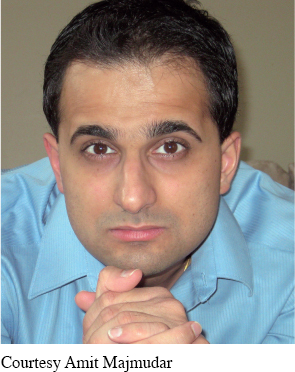8.19
627
Dothead
Amit Majmudar

Poet and novelist Amit Majmudar (b. 1979) practices as a diagnostic nuclear radiologist in Dublin, Ohio, where he lives with his wife, twin sons, and daughter. He earned a BS at the University of Akron and an MD at Northeast Ohio Medical University. The recipient of several literary prizes, Majmudar has published two novels, Partitions (2011) and The Abundance (2013), and two poetry collections, 0˚, 0˚ (2009) and Heaven and Earth (2011). “Dothead” was published in the New Yorker in 2011.
KEY CONTEXT Spiritually important in Hindu culture, the bindi, or “red dot,” is a mark made of vermilion powder that Indian women wear on the forehead. Originally a mark of wisdom, the bindi has come to symbolize the love and commitment of a wife to her husband. The figure Nataraja is a depiction of the Hindu god Shiva as the Lord of the Dance and destroyer of the universe, paving the way for a new creation and signifying the never-
Well yes, I said, my mother wears a dot.
I know they said “third eye” in class, but it’s not
an eye eye, not like that. It’s not some freak
third eye that opens on your forehead like
5 on some Chernobyl baby. What it means
is, what it’s showing is, there’s this unseen
eye, on the inside. And she’s marking it.
It’s how the X that says where treasure’s at
is not the treasure, but as good as treasure. —
10 All right. What I said wasn’t half so measured.
In fact, I didn’t say a thing. Their laughter
had made my mouth go dry. Lunch was after
World History; that week was India — myths,
caste system, suttee, all the Greatest Hits.
15 The white kids I was sitting with were friends,
at least as I defined a friend back then.
So wait, said Nick, does your mom wear a dot?
I nodded, and I caught a smirk on Todd —
She wear it to the shower? And to bed? —
20 while Jesse sucked his chocolate milk and Brad
was getting ready for another stab.
628
I said, Hand me that ketchup packet there.
And Nick said, What? I snatched it, twitched the tear,
and squeezed a dollop on my thumb and worked
25 circles till the red planet entered the house of war
and on my forehead for the world to see
my third eye burned those schoolboys in their seats,
their flesh in little puddles underneath,
pale pools where Nataraja cooled his feet.
Understanding and Interpreting
In line 10, the speaker admits, “What I said wasn’t half so measured.” What does the difference between what the speaker thinks and what he says reveal about him?
What is the effect of the boys’ laughter on the speaker? Why might he have reacted this way?
What evidence from the poem suggests that the speaker is now older and looking back on the event? What does the older speaker likely think of his younger self? Why?
Why does the speaker do what he does with the ketchup at the end of the poem? What does that action, compared to other possible actions, suggest about him?
What is the poem saying about assimilation and cultural differences, at least among adolescent boys?
Analyzing Style, Language, and Structure
This poem has a conversational feel, as if the speaker were just telling his audience a story. What words, phrases, and other stylistic elements create this feel?
What is the attitude of the speaker toward the way that school, history class in particular, teaches about non-
American cultures? What words or phrases capture this tone? While the speaker refers to the boys as “friends” (l. 15), what does the poet include to show that the speaker is separated from them?
In line 27, the speaker does not refer to the boys as friends or by their names, instead calling them “those schoolboys.” How does this shift help to illustrate the meaning of the poem?
Majmudar begins the poem right in the middle of the speaker’s conversation with his friends about the dot his mother wears, then moves back in time to the history class, and then returns to the conversation. What effect is achieved through this structure of the poem?
As the speaker is rubbing the ketchup into his forehead, he says he worked circles “till the red planet entered the house of war” (l. 25). Explain how this metaphor reflects the speaker’s attitude toward the other boys.
After rereading the Key Context note, explain the effect of the allusion to Nataraja. How does it reflect and support the overall meaning of the poem?
629
Connecting, Arguing, and Extending
Describe a time when you either stood up for an unpopular belief or chose to remain silent. Why did you act the way you did? How was your experience similar to or different from that of the speaker in this poem?
Many high schools have “multicultural” assemblies, celebrations of Black History Month, or similar opportunities for students to learn about other cultures. In what ways are these approaches successful or beneficial? How do you think students can best learn about other cultures? Write an argument about the most effective ways that a school can teach students about other cultures.
The bindi is only one example of an outward marking used in a particular culture. Research other types of outward markings and explain their purposes.